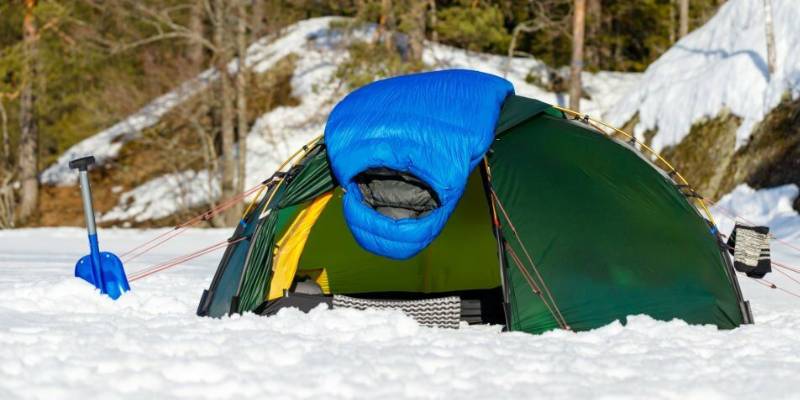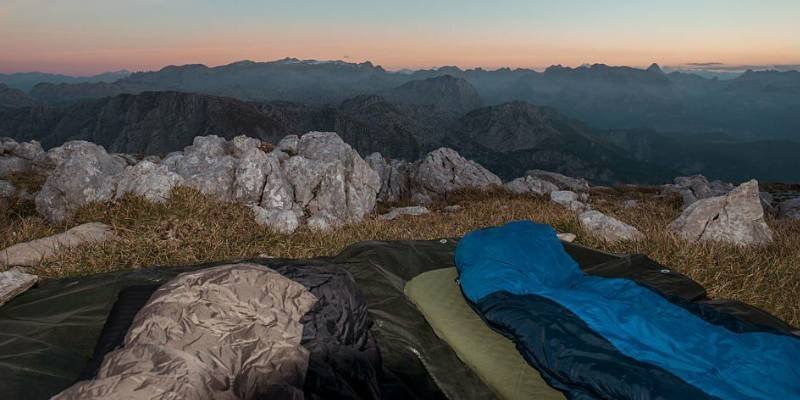Down vs Synthetic Sleeping Bags
When shopping for a new sleeping bag, one of the most important decisions you need to make is between down and synthetic sleeping bags. Today’s purchase advice is about comparing down vs synthetic sleeping bags.
Besides the most important advantages and disadvantages of both materials, we also explain how the respective insulation works and how the quality can be determined. Finally, we will show you when a synthetic fiber or down sleeping bag is worthwhile and for whom.
What is Down Filling in Sleeping Bags?

Down is known as a high-quality filling material for sleeping bags. However, down is not the same as bird feathers. Instead, we find down sleeping bag is soft, fluffy plumage in waterfowl like ducks and geese just below the outer plumage. In down sleeping bags, insulation is achieved through the formation of air chambers.
Many manufacturers now use a mixture of down and feathers to fill their sleeping bags. And the mixing ratio varies greatly. The proportion of small springs is about five percent in expensive premium models – this part is usually only added for reasons of stability.
The following factors play a decisive role in the quality of the down:
- Bird species
- The age of the animals
- Time of plucking
- Climate at the place of origin of the animals
- Nutrition of the animals
Waterfowl in colder regions provide better quality down filling. For example, goose down is of higher quality than duck down. Goose down is more expensive, so duck down has increasingly been used in production in recent years. In addition, age also determines the quality: older animals have fuller and more stable down.
The decisive indicator for the quality of the down is the so-called fill power of the down. It indicates how much an ounce of down (which is equivalent to approximately 28.34 grams) expands after being subjected to a specific pressure in a cylinder. The faster and more voluminous, the better the down insulation that can be achieved.
This filling power of the down (also “loft”) is given in cubic inches:
- Usable fill power from 500 cubic in.
- Good bulking power from 650 cubic in.
- From 900 cubic in. excellent fill power, top models
The highest quality sleeping bags use a mix ratio of a maximum of five percent small feathers with 95 percent down and deliver an excellent fill power of 900 cubic inches and more. However, the proportion of small springs for a usable sleeping bag should be no more than 20 percent.
Incidentally, most duck down reaches a maximum of 800 cubic inches. So when making your selection, pay attention to the bird species and, above all, the fill power if you want a premium down sleeping bag.
An 800 fill power down sleeping bag uses less down than a 700-fill model to fill the space and achieve the same insulation – and therefore weighs less! Besides the lower weight, the reduced pack size – for backpackers, for example – is also exciting. In addition, down can absorb body moisture much better than other materials.
However, down filling does not only have advantages. The main point of criticism lies in the problem that down should not get wet – otherwise, there is a risk of a reduction in the bulkiness. That is why washing and cleaning a sleeping bag should be reduced to a minimum.
Above all, high-quality down sleeping bags require a certain discipline – for example avoiding dirt and washing too often. Another disadvantage is the often incomprehensible treatment of the animals: plucking is painful for the animals, so many manufacturers state that they only use slaughtered animals to get down.
If you want to buy down products with a clear conscience, you should pay attention to the so-called “Global Traceable Down Standard” (Global TDS). This is currently the strongest animal protection standard and is monitored by an independent organization (NSF). Among other things, this states that the down does not come from live plucking or force fattening.
| Advantages | Disadvantages |
|
|
What is synthetic filling in sleeping bags?

The insulating capacity of the synthetic fiber filling in sleeping bags is due to the loft of synthetic fibers (mostly polyester), which form air chambers and thus repel the cold. In order for the insulating effect to work at all, a synthetic fiber surface has to be as smooth as possible. This is the only way for the synthetic fibers to puff up.
To achieve this, the surface of the fiber is coated with a smoothing layer of silicone. In this way, the fibers cannot impede one another or even get caught. Synthetic fibers themselves are rough and anything but smooth. So this silicone layer is absolutely necessary to create a good quality synthetic filling for the sleeping bag.
However, the more robust and smooth the synthetic fiber is to be, the higher the manufacturing costs. Since these desired properties are decisive for the quality, it quickly becomes clear why there is often a huge price difference between cheap and expensive synthetic sleeping bags.
While cheap models quickly lose their fill power and become unusable, premium synthetic fiber fillings are particularly durable and promise excellent insulation against the cold. Overall, a sleeping bag with a synthetic fiber filling is significantly cheaper to buy than a down sleeping bag. The price is a decisive argument, especially for campers on a tight budget.
The decisive advantages over down fillings: Synthetic fiber sleeping bags dry faster and insulate even when they are damp. As a result, high-quality fiber fillings last longer, and synthetic fibers do not lose their loft so easily through regular washing.
| Advantages | Disadvantages |
|
|
What good is the mixture of fibers and down?

Some manufacturers have deliberately started selling jackets and sleeping bags as a mixture of down and synthetic fibers on the market. In some sleeping bags, the down and fiber fillings are mixed and distributed over the entire length of the sleeping bag.
Other synthetic down models use the specific advantages of each type: There are sleeping bags in which the lower part is filled with robust synthetic fibers, while particularly lofty down is used on top.
| Advantages | Disadvantages |
|
|
Down vs synthetic sleeping bags: which filling is right for me?
Due to the individual advantages and disadvantages of the different fillings, the purchase decision should be made based on the following criteria:
- Budget
- Kind of trip
- Local climate and weather
- How much space can the sleeping bag take up?
- How light does the sleeping bag have to be?
Campers on a tight budget should almost always use the cheaper synthetic fiber sleeping bag. This is also due to the fact that care for down fillings is more complex and errors can be very expensive because of the high sensitivity. If you are a backpacker and travel light per se, you will reach for high-quality down. This is how we save space and weight. In addition, this filling is ideal for cool, dry regions. Winter campers also prefer this filling predominantly.
Festival campers should use synthetic fiber sleeping bags. Mishaps happen at hearty music festivals or anywhere alcohol flows freely. So the beautiful new sleeping bag is quickly stained and has to be washed. And this is exactly where synthetic fiber fillings score, which we can wash more often without endangering the insulation. Allergy sufferers almost always use synthetic fiber fillings. In any case, the fibers are allergy-friendly.
Frequently Asked Questions (FAQs)
Which is better for wet conditions: down or synthetic?
Synthetic sleeping bags have an advantage in wet conditions. They retain their insulating properties when damp, whereas down sleeping bags lose their effectiveness when wet. This makes synthetic bags a more reliable choice for humid or rainy environments.
Can synthetic sleeping bags be compressed as easily as down bags?
Synthetic bags are less compressible compared to down bags. Down’s natural loftiness allows for excellent compression, making it easier to pack in a smaller space. However, advancements in synthetic insulation technology have improved compressibility in recent years.
Which type of sleeping bag is more suitable for long-term use?
Down sleeping bags have a longer lifespan compared to synthetic ones if you properly care for them. They maintain their loft and insulation properties for a longer period, making them a better choice for extended use over several seasons.





